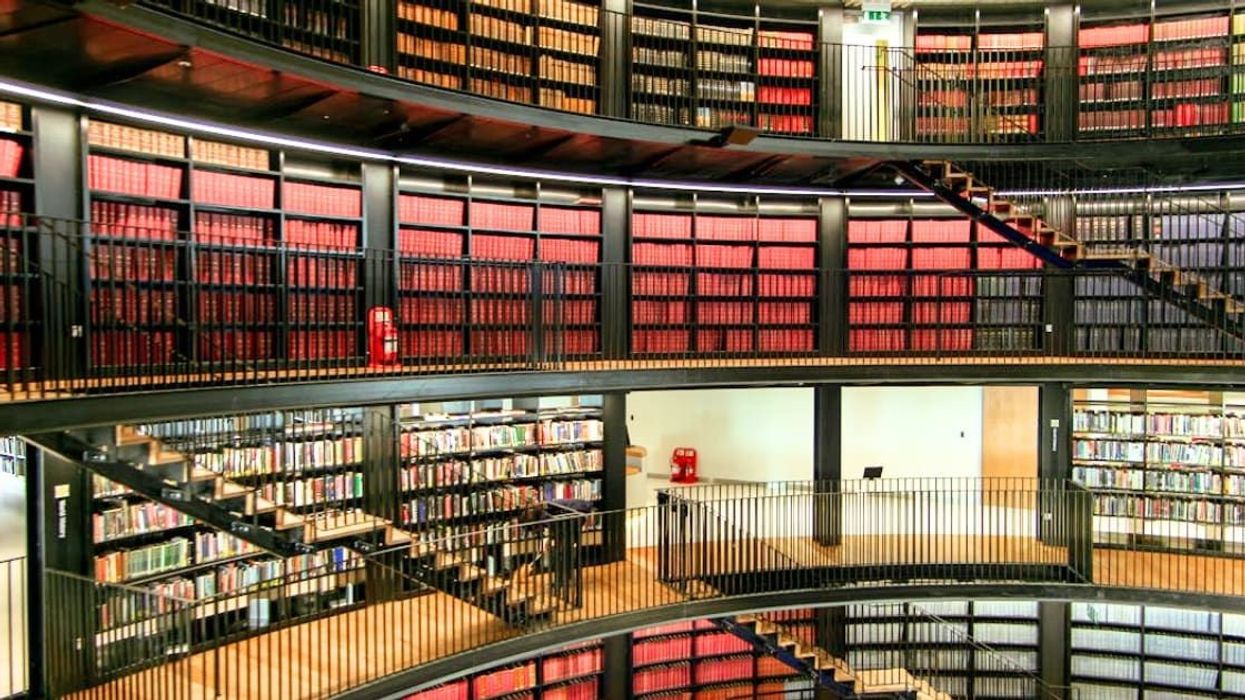Nestled in the north of Norway’s capital, Oslo, is a “forest within a forest” marked by pebble trails, pine needles, burnt logs, and the aroma of Norwegian coffee. Each year, a “Handover ceremony” is organized in this nestling forest, where authors sit shoeless, and foresters serve them coffee brewed in open-fire pots along with chocolates as part of their ritual. This forest is a part of the surreal “Future Library” project.
The Future Library is a century-long project conceived by Scottish artist Katie Paterson. The project aims to grow thousands of trees in the forest, whose wood will be used to publish a series of anthologies from the selected hundred authors who have participated. Each year, one author submits a manuscript which is held in trust and remains unpublished until 2114.
The current manuscripts are locked inside the Silent Room in the heart of the city’s public library, the Deichman Bjorvika. This room is a secretive chamber hidden on Deichman’s fifth floor. Each year, a text is placed in the glass drawers of this room. According to an Instagram post, the room was designed by Paterson and architects Atelier Oslo and Lund Hagem. People say the room is so tranquil that it sounds like a meditation temple. Some of the writers who have submitted their manuscripts until now include Margaret Atwood, David Mitchell, Sjón, Elif Shafak, Han Kang, Karl Ove Knausgård, Ocean Vuong, Tsitsi Dangarembga, and Judith Schalansky. Atwood was the first author who handed over her manuscript, “Scribbler Moon,” in May 2014.
According to Vuong, the Future Library is like his family. For him, the handover ceremony is a very emotional experience. On the other side, for Zimbabwean novelist Tsitsi Dangarembga, who joined the Future Library in 2021, the project relates to something archetypal within humans. Talking about the project, Future Library’s 2017 author Elif Shafak told Al Jazeera, “This is a project of faith, faith that… our words today will matter to people of future generations, that there will be a need for literature, there will be a need for poetry, for novels, for ideas… for emotional connections.”
The idea of the Future Library, a brainchild of Paterson, first popped into her mind when she was on a train journey. She was delightfully immersed in drawing tree ring doodles on a napkin. But it turned out to be much more than just tree rings. She became keen to explore primordial landscapes, and that’s when she decided to create something like a century-old time capsule.
Now, as the project reaches its tenth year, the staff has curated some contingency plans. The paper copies of the manuscripts are secured, and the tree roots have been treated against possible insect infestations. Nonetheless, the idea of a secret library where no book is readable sounds dreamlike.



















 Ladder leads out of darkness.Photo credit
Ladder leads out of darkness.Photo credit  Woman's reflection in shadow.Photo credit
Woman's reflection in shadow.Photo credit  Young woman frazzled.Photo credit
Young woman frazzled.Photo credit 




Will your current friends still be with you after seven years?
Professor shares how many years a friendship must last before it'll become lifelong
Think of your best friend. How long have you known them? Growing up, children make friends and say they’ll be best friends forever. That’s where “BFF” came from, for crying out loud. But is the concept of the lifelong friend real? If so, how many years of friendship will have to bloom before a friendship goes the distance? Well, a Dutch study may have the answer to that last question.
Sociologist Gerald Mollenhorst and his team in the Netherlands did extensive research on friendships and made some interesting findings in his surveys and studies. Mollenhorst found that over half of your friendships will “shed” within seven years. However, the relationships that go past the seven-year mark tend to last. This led to the prevailing theory that most friendships lasting more than seven years would endure throughout a person’s lifetime.
In Mollenhorst’s findings, lifelong friendships seem to come down to one thing: reciprocal effort. The primary reason so many friendships form and fade within seven-year cycles has much to do with a person’s ages and life stages. A lot of people lose touch with elementary and high school friends because so many leave home to attend college. Work friends change when someone gets promoted or finds a better job in a different state. Some friends get married and have children, reducing one-on-one time together, and thus a friendship fades. It’s easy to lose friends, but naturally harder to keep them when you’re no longer in proximity.
Some people on Reddit even wonder if lifelong friendships are actually real or just a romanticized thought nowadays. However, older commenters showed that lifelong friendship is still possible:
“I met my friend on the first day of kindergarten. Maybe not the very first day, but within the first week. We were texting each other stupid memes just yesterday. This year we’ll both celebrate our 58th birthdays.”
“My oldest friend and I met when she was just 5 and I was 9. Next-door neighbors. We're now both over 60 and still talk weekly and visit at least twice a year.”
“I’m 55. I’ve just spent a weekend with friends I met 24 and 32 years ago respectively. I’m also still in touch with my penpal in the States. I was 15 when we started writing to each other.”
“My friends (3 of them) go back to my college days in my 20’s that I still talk to a minimum of once a week. I'm in my early 60s now.”
“We ebb and flow. Sometimes many years will pass as we go through different things and phases. Nobody gets buttsore if we aren’t in touch all the time. In our 50s we don’t try and argue or be petty like we did before. But I love them. I don’t need a weekly lunch to know that. I could make a call right now if I needed something. Same with them.”
Maintaining a friendship for life is never guaranteed, but there are ways, psychotherapists say, that can make a friendship last. It’s not easy, but for a friendship to last, both participants need to make room for patience and place greater weight on their similarities than on the differences that may develop over time. Along with that, it’s helpful to be tolerant of large distances and gaps of time between visits, too. It’s not easy, and it requires both people involved to be equally invested to keep the friendship alive and from becoming stagnant.
As tough as it sounds, it is still possible. You may be a fortunate person who can name several friends you’ve kept for over seven years or over seventy years. But if you’re not, every new friendship you make has the same chance and potential of being lifelong.